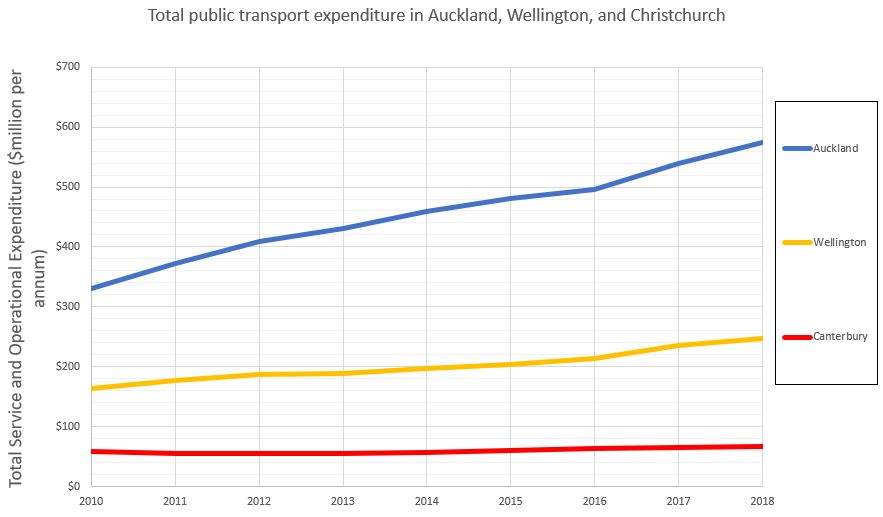People give a lot of different reasons for why public transport in Christchurch is not doing well. They talk about things like topography, sprawling city shape, a car-centric-culture. These things all play a part, but I think there is one much simpler reason that dwarfs all these in importance.
NZTA publish public transport expenditure here:
I’ve taken this information and put it in a graph. It shows public transportation expenditure from 2010 to 2018 for Canterbury, Wellington and Auckland. Note this is just annual operating expenditure, not the big capital expenditure projects.

And because kiwis love everything to be reported “per capita” here is the same information per capita:

It shows that Canterbury spends far less per capita than Wellington and Auckland. And the gap is widening: Wellington and Auckland are both increasing their expenditure per capita, while Canterbury has flat-lined (which is really a decrease in real dollar-value terms).
Auckland, Wellington and Christchurch also publish patronage in various places online. Here are the boardings per capita in each city over the same period.

Wellington has high patronage, and has stayed consistently high for a long time. Auckland is lower but growing fast, and will probably surpass Wellington in another few years. Christchurch is low and shrinking.
Christchurch spends a fraction on public transport of what Auckland and Wellington spend, and we get a fraction of the people using it. Even accounting for the earthquake effect, there is a strong correlation between how much money you invest in public transport and the number of people who use it. I know correlation doesn’t necessarily mean causation, but it seems to me fairly likely that there is a causal link here.
Everyone always talks about the earthquakes being the big factor in Christchurch’s public transport decline. But I no longer think that’s the case. There is an even bigger problem: in the last decade we have chosen not to fund public transport properly.
We can go a step further and say that this is largely the result of the decision to remove elected councillors from Ecan and insert commissioners, whose main focus was water management. They did not really have any interest in transport at all, preferring to maintain the status quo for a decade. This has had a more destructive impact on transport in Christchurch than the earthquake did.
Luckily the solution in some ways is simple – increase funding!
Some people won’t like the idea of spending more money, but remember that it’s spending less money overall, because we save on expensive roading and parking infrastructure, as well as all the internal costs of every household in the city having to own and operate multiple private vehicles. Remember that driving is the most expensive way of getting around. PwC’s competitive cities reporting concluded that Christchurch’s biggest failing in the last decade is high transport costs resulting from dependence on the private car for most trips, which largely wipe out all the good things we’ve done in terms of economic growth.
“Unlike these Australian cities however, transport costs have increased significantly.
The competitiveness challenge for Christchurch is maintaining strong income growth, while avoiding rising transport costs.
There are a number of options to consider, including greater housing choices with proximity to employment hubs and amenities and a greater balance in investment on the outskirts of the city, between highway infrastructure, public transport and walking and cycling infrastructure.”
The funding balance in Christchurch has been wrong for the last decade. To fix transport in Christchurch, we need to fix the funding balance.
2 thoughts on “Public Transport Funding Comparison”